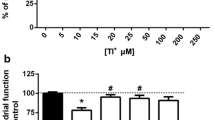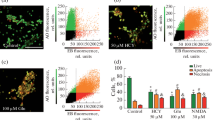Abstract
Kainic acid is known to stimulate the release of glutamate (GLU) and aspartate (ASP) from presynaptic neurons. It has been suggested that the enhanced release of these endogenous EAA's plays a significant role in the excitotoxic effects of KA. Domoic acid (DOM), a shellfish toxin, is structurally similar to KA, and has been shown to be 3–8 times more toxic than KA. In this study, effects of KA and DOM on the release of GLU and ASP from rat brain synaptosomes were investigated. Amino acid analysis was performed by the reversed phase HPLC, following derivatization with 9-fluorenylmethyl chloroformate (FMOC). Potassium chloride (40 mM) was used as a positive control, and stimulated GLU release from rat brain synaptosomes in presence or absence of Ca2+. DOM enhanced the release of GLU, whereas KA stimulated the release of both GLU and ASP from synaptosomes in the presence of Ca2+. However, their potency to stimulate GLU and ASP release was enhanced in absence of Ca2+. These results indicate that diferent mechanisms may be involved in the release of GLU and ASP in response to DOM and KA, and that neurotransmitter release appeared to be highly specific for these agonists. It would appear that DOM and KA may interact with different receptors on the presynaptic nerve terminal, and/or activate different subtypes of voltage-dependent Ca2+ channels to promote influx of Ca2+ which is targeted for different pools of neurotransmitters.
Similar content being viewed by others
Abbreviations
- ANOVA:
-
analysis of variance
- ASP:
-
aspartate
- DOM:
-
domoic acid
- DHKA:
-
dihydrokainic acid
- EAA:
-
excitatory amino acid
- FMOC:
-
9-fluorenylmethyl chloroformate
- GLU:
-
glutamate
- KA:
-
kainic acid
References
Rothman SM, Olney JW: Excitotoxicity and the NMDA receptor. Trends in Pharmacol Sci 10: 299–302, 1987
Meldrum B, Garthwaite J: Excitatory amino acid neurotoxicity and degenerative disease. Trends in Pharmacol Sci 11: 379–387, 1990
Stewart GR, Zorumski CF, Price MT, Olney JW: Domoic acid: a dementia-inducing excitotoxic food poison with kainic acid receptor specificity. Exp Neurol 110: 127–138, 1990
Debonnel G, Beauschene L, De Montigny C: Domoic acid, the alleged ‘mussel toxin’, might produce its neurotoxic effect through kainate receptor activation: an electrophysiological study in the rat dorsal hippocampus. Can J Physiol Pharmacol 67: 29–33, 1989
Debonnel G, Weiss M, De Montigny C: Reduced neuroexcitatory effect of domoate following mossy fibre denervation of the rat dorsal hippocampus: further evidence that toxicity of domoic acid involves kainate receptor activation. Can J Physiol Pharmacol 67: 904–908, 1989
Tasker RAR, Connell BJ, Strain SM: Pharmacological, behavioral, and morphological studies of domoic acid toxicityin vivo. Eur J Pharmacol 183: 959, 1990
Strain S, Tasker RAR: Hippocampal damage produced by systemic injections of domoic acid in mice. Neuroscience 44: 343–352, 1991
Connick JH, Stone TW: The effect of kainic, quinolinic and L-kainic acids on the release of endogenous amino acids from rat brain slices. Biochem Pharmacol 35: 3631–3635, 1986
Pastuszko A, Wilson DF, Erecinska M: Effects of kainic acid in rat brain synaptosomes: involvement of calcium. J Neurochem 43: 747–754, 1984
Young AMJ, Crowder JM, Bradford HF: Potentiation by kainate of excitatory amino acid release in striatum: complementaryin vivo andin vitro experiments. J Neurochem 50: 337–345, 1988
Ferkany JW, Zzczek R, Coyle JT: Kainic acid stimulates excitatory amino acid neurotransmitter release at presynaptic receptors. Nature 298: 757–759, 1982
Poli A, Contestabile, A, Migani P, Rossi L, Rondelli C, Virgili M, Bissoli R, Barnabei O: Kainic acid differentially affects the synaptosomal release of endogenous and exogenous neuro-transmitters. J Neurochem 45: 1677–1686, 1985
Pocock JM, Murphie HM, Nicholls DG: Kainic acid inhibits the synaptosomal plasma membrane glutamate carrier and allows glutamate leakage from the cytoplasm but does not affect glutamate exocytosis. J Neurochem 50: 745–751, 1988
Levi G, Patrizio M, Gallo V: Release of endogenous and newly synthesized glutamate and of other amino acids induced by non-N-methyl-D-aspartate receptor activation in cerebellar granule cells. J Neurochem 56: 199–206, 1991
Terrian DM, Johnston D, Claiborne BJ, Ansah-Yiadom R, Stritmatter WJ, Rea MA: Glutamate and dynorphin release from a subcellular fraction enriched in hippocampal mossy fiber synaptosomes. Brain Res Bull 21: 343–351, 1988
Hori N, French-Mullen JMH, Carpenter DO: Kainic acid responses and toxicity show pronounced Ca2+ dependence. Brain Res 358: 380–384, 1985
Werner P, Voight M, Keinanen K, Wisden W, Seeburg PH: Cloning of a putative high-affinity kainate receptor expressed predominantly in hippocampal CA3 cells. Nature 351: 742–744, 1991
McMahon HT, Nicholls DG: Transmitter glutamate release from isolated nerve terminals: Evidence for biphasic release and triggering by localized Ca2+. J Neurochem, 56: 86–94, 1991
Arvin B, Neville LF, Pan J, Roberts PJ: 2-Chloradenosine attenuates kainic acid-induced toxicity within the rat striatum: relationship to release of glutamate and Ca2+ influx. Br. J. Pharmacol. 98: 225–235, 1989
Holopainen I, Kontro P: Glutamate release from cerebellar granule cells differentiating in culture: modulation of the K+-stimulated release by inhibitory amino acids. Neurochem Intl 12: 155–161, 1988
Nicholls DG, Sihra TS: Synaptosomes possess an exocytotic pool of glutamate. Nature 321: 772–773, 1986
Kauppinen RA, McMahon HT, Nichols DG: Ca2+-dependent and Ca2+-independent glutamate release, energy status and cytosolic, free Ca2+ concentration in isolated nerve terminals following metabolic inhibition: possible relevance to hypoglycaemia and anoxia. Neuroscience 27: 175–182, 1988
Nicholls D, Attwell D: The release and uptake of excitatory amino acids. Trends in Pharmacol Sci 11: 462–468, 1990
Notman H, Whitney R, Jhamandas, K: Kainic acid evoked release of D-[3H]aspartate from rat striatumin vitro: characterization and pharmacological modulation. Can J Physiol Pharmacol 62: 1070–1077, 1984
Booth RF, Clarke JB: A rapid method for the preparation of relatively pure metabolically competent synaptosomes from rat brain. Biochem J. 176: 365–370, 1978
Lowry OH, Rosebrough NJ, Farr AL, Randall RJ: Protein measurement with the Folin phenol reagent J Biol Chem 193: 265–275, 1951
Pocklington R, Bates SS, Milley JE, Bird CJ, DeFreitas ASW, Quilliam MA: Trace determination of domoic acid in seawater and phytoplankton by high performance liquid chromatography of the fluorenylmethoxycarbonyl (FMOC) derivative. Intl J Environ Anal Chem 38: 351–368, 1990
Ferguson GA: In Statistical analysis in psychology and education. McGraw Hill Book Company, New York, 1976
Teitelbaum JS, Zotorre RJ, Carpenter S, Gendron P, Evans AC, Gjedde A, Cashman NR: Neurologic sequelae of domoic acid intoxication due to ingestion of contaminated mussels. New Eng J Med 322: 1781–1787, 1990
Terrian DM, Conner-Kerr TA, Privette TH, Gannon RL: Domoic acid enhances the K+-evoked release of endogenous glutamate from guinea pig hippocampal mossy fiber synaptosomes. Brain Res. 551: 303–307, 1991
Nijjar MS, MacKenzie DM, Brown JA: A procedure for large-scale purification of domoic acid from toxic blue mussels (Mytilus edulis) Mol Cell Biochem 115: 213–217, 1992
Romano-Silva MA, Ribeiro-Santos R, Ribero AM, Gomez MV, Diniz OR, Cordeiro MN, Brammer MJ: Rat cortical synaptosomes have more than one mechanism for Ca2+ entry linked to rapid glutamate release: Studies using the phoneutria nigriventer toxin PhTX2 and potassium depolarization. Biochem J 296: 313–319, 1993
Burke SP, Adams ME, Taylor CP: Inhibition of endogenous glutamate release from hippocampal tissue by Ca2+ channel toxins. Eur J Pharmacol 238: 383–386, 1993
Dakshinamurti K, Sharma SK, Sundaram M: Domoic acid induced seizure activity in rats. Neurosci Lett 127: 193–197, 1991
Dakshinamurti K, Sharma SK, Sundaram M, Watanabe T: Hippocampal changes in developing postnatal mice following intrauterine exposure to domoic acid. J Neurosci 13: 4486–4495, 1993
Author information
Authors and Affiliations
Rights and permissions
About this article
Cite this article
Brown, J.A., Nijjar, M.S. The release of glutamate and aspartate from rat brain synaptosomes in response to domoic acid (amnesic shellfish toxin) and kainic acid. Mol Cell Biochem 151, 49–54 (1995). https://doi.org/10.1007/BF01076895
Received:
Accepted:
Issue Date:
DOI: https://doi.org/10.1007/BF01076895




